Perovskites to Photonics: Engineering NIR LEDs for Photobiomodulation
Abstract
1. Introduction
2. NIR Emission for Photobiomodulation
2.1. Biological Basis of PBM
2.2. Clinical Applications
2.3. Light Sources: Lasers vs. LEDs
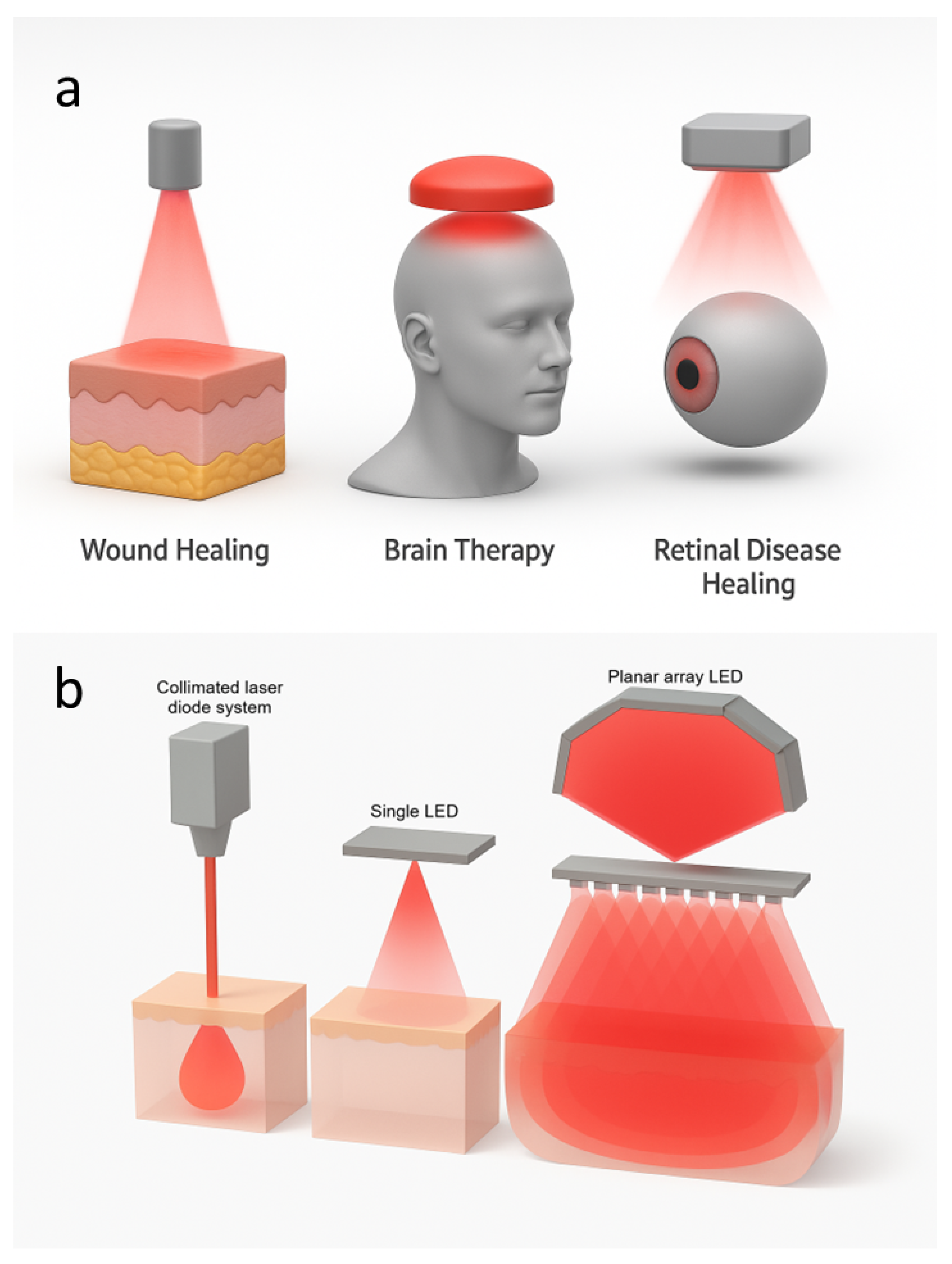
2.4. Device Metrics and Dosimetry
2.5. Translating Clinical Protocols into Device Parameters
2.6. Thermal Load and Worked Example
2.7. Challenges and Limitations
2.8. Future Directions
3. NIR LED Emissive Materials
3.1. Conventional Semiconductors (Groups III–V, IV, II–VI)
3.2. Small-Molecule and Polymer LEDs
3.3. Perovskite LEDs
3.4. Non-Toxic Emitters
3.5. Comparative Performance Analysis
4. Photonic, Plasmonic and Optoelectronic Engineering for NIR LEDs
5. Concluding Remarks and Perspectives
Funding
Data Availability Statement
Acknowledgments
Conflicts of Interest
References
- Lee, S.Y.; Jeon, S.; Kwon, Y.W.; Kwon, M.; Kang, M.S.; Seong, K.Y.; Park, T.E.; Yang, S.Y.; Han, D.W.; Hong, S.W.; et al. Combinatorial wound healing therapy using adhesive nanofibrous membrane equipped with wearable LED patches for photobiomodulation. Sci. Adv. 2022, 8, e1646. [Google Scholar] [CrossRef]
- Yadav, A.; Gupta, A. Noninvasive red and near-infrared wavelength-induced photobiomodulation: Promoting impaired cutaneous wound healing. Photodermatol. Photoimmunol. Photomed. 2017, 33, 4–13. [Google Scholar] [CrossRef]
- Purushothuman, S.; Johnstone, D.M.; Nandasena, C.; Mitrofanis, J.; Stone, J. Photobiomodulation with near infrared light mitigates Alzheimer’s disease-related pathology in cerebral cortex–evidence from two transgenic mouse models. Alzheimer’s Res. Ther. 2014, 6, 2. [Google Scholar] [CrossRef]
- Min, P.K.; Goo, B.L. 830 nm light emitting diode low level light therapy (LED-LLLT) enhances wound healing: A preliminary study. Lasers Surg. Med. 2013, 22, 43–49. [Google Scholar] [CrossRef]
- Oyebode, O.; Houreld, N.N.; Abrahamse, H. Photobiomodulation in Diabetic Wound Healing: A Review of Red and Near-infrared Wavelength Applications. Cell Biochem. Funct. 2021, 39, 596–612. [Google Scholar] [CrossRef] [PubMed]
- Cha, G.D.; Kim, D.; Kim, D.C. Wearable and Implantable Light-Emitting Diodes and Their Biomedical Applications. Korean J. Chem. Eng. 2024, 41, 1–24. [Google Scholar] [CrossRef]
- Felician, M.C.P.; Belotto, R.; Tardivo, J.P.; Baptista, M.S.; Martins, W.K. Photobiomodulation: Cellular, molecular, and clinical aspects. J. Photochem. Photobiol. B 2023, 17, 100197. [Google Scholar] [CrossRef]
- Nairuz, T.; Cho, S.; Lee, J.H. Photobiomodulation Therapy on Brain: Pioneering an Innovative Approach to Revolutionize Cognitive Dynamics. Cells 2024, 13, 966. [Google Scholar] [CrossRef]
- Liu, Y.; Di Stasio, F.; Bi, C.; Zhang, J.; Xia, Z.; Shi, Z.; Manna, L. Near-Infrared Light Emitting Metal Halides: Materials, Mechanisms, and Applications. Adv. Mater. 2024, 36, 2312482. [Google Scholar] [CrossRef]
- Triana, M.A.; Restrepo, A.A.; Lanzafame, R.J.; Palomaki, P.; Dong, Y. Quantum dot light-emitting diodes as light sources in photomedicine: Photodynamic therapy and photobiomodulation. J. Phys. Mater. 2020, 3, 032002. [Google Scholar] [CrossRef]
- Xiong, W.; Zhang, C.; Fang, Y.; Peng, M.; Sun, W. Progresses and Perspectives of Near-Infrared Emission Materials with “Heavy Metal-Free” Organic Compounds for Electroluminescence. Polymers 2023, 15, 98. [Google Scholar] [CrossRef] [PubMed]
- Liu, Y.; Ma, Z.; Zhang, J.; He, Y.; Dai, J.; Li, X.; Shi, Z.; Manna, L. Light-Emitting Diodes Based on Metal Halide Perovskite and Perovskite Related Nanocrystals. Adv. Mater. 2025, 37, 2415606. [Google Scholar] [CrossRef] [PubMed]
- Kim, D.Y.; Jung, J.G.; Lee, Y.J.; Park, M.H. Lead-Free Halide Perovskite Nanocrystals for Light-Emitting Diodes. Materials 2023, 16, 6317. [Google Scholar] [CrossRef] [PubMed]
- Yan, B.; Zhou, J.; Yan, F.; Gao, M.; Tang, J.; Huang, L.; Luo, Y. Unlocking the potential of photobiomodulation therapy for brain neurovascular coupling: The biological effects and medical applications. J. Cereb. Blood Flow Metab. 2025, 45, 800–830. [Google Scholar] [CrossRef]
- Jeon, Y.; Choi, H.R.; Kwon, J.H.; Choi, S.; Nam, K.M.; Park, K.C.; Choi, K.C. Sandwich-structure transferable free-form OLEDs for wearable and disposable skin wound photomedicine. Light Sci. Appl. 2019, 8, 114. [Google Scholar] [CrossRef]
- Desmet, K.D.; Paz, D.A.; Corry, J.J.; Eells, J.T.; Wong-Riley, M.T.; Henry, M.M.; Buchmann, E.V.; Connelly, M.P.; Dovi, J.V.; Liang, H.L.; et al. Clinical and Experimental Applications of NIR-LED Photobiomodulation. Photomed. Laser Surg. 2006, 24, 121–128. [Google Scholar] [CrossRef]
- Yokomizo, S.; Kopp, T.; Roessing, M.; Morita, A.; Lee, S.; Cho, S.; Ogawa, E.; Komai, E.; Inoue, K.; Fukushi, M.; et al. Near-Infrared II Photobiomodulation Preconditioning Ameliorates Stroke Injury via Phosphorylation of eNOS. Stroke 2024, 55, 1641–1649. [Google Scholar] [CrossRef]
- Ivandic, B.; Ivandic, T. Low-level laser therapy improves vision in patients with age-related macular degeneration. Photomed. Laser Surg. 2008, 26, 241–245. [Google Scholar] [CrossRef]
- Tang, J.; Herda, A.; Kern, T. Photobiomodulation in the treatment of patients with non-center-involving diabetic macular oedema. Br. J. Ophthalmol. 2014, 98, 1013–1015. [Google Scholar] [CrossRef]
- Geneva, I.I. Photobiomodulation for the treatment of retinal diseases: A review. Int. J. Ophthalmol. 2016, 9, 145–152. [Google Scholar] [CrossRef]
- Natoli, R.; Valter, K.; Barbosa, M.; Dahlstrom, J.; Rutar, M.; Kent, A.; Provis, J. 670 nm photobiomodulation as a novel protection against retinopathy of prematurity: Evidence from oxygen induced retinopathy models. PLoS ONE 2013, 8, e72135. [Google Scholar] [CrossRef]
- Ivandic, B.; Ivandic, T. Low-level laser therapy improves visual acuity in adolescent and adult patients with amblyopia. Photomed. Laser Surg. 2012, 30, 167–171. [Google Scholar] [CrossRef]
- Ivandic, B.; Ivandic, T. Low-level laser therapy improves vision in a patient with retinitis pigmentosa. Photomed. Laser Surg. 2014, 32, 181–184. [Google Scholar] [CrossRef]
- Eells, J.; Henry, M.; Summerfelt, P.; Wong-Riley, M.; Buchmann, E.; Kane, M.; Whelan, N.; Whelan, H. Therapeutic photobiomodulation for methanol-induced retinal toxicity. Proc. Natl. Acad. Sci. USA 2003, 100, 3439–3444. [Google Scholar] [CrossRef]
- Martins, M.D.; Marques, M.M.; Esteves-Pereira, T.C.; Arany, P.R. Basic Principles of Physics in Photobiomodulation. In Photobiomodulation Therapy in Oral Medicine: Evidence-Based Clinical Protocols; Springer Nature: Cham, Switzerland, 2025; pp. 3–10. [Google Scholar] [CrossRef]
- IUPAC. Compendium of Chemical Terminology, 5th ed.; The “Gold Book”; IUPAC: Research Triangle Park, NC, USA, 2025; p. 409. [Google Scholar] [CrossRef]
- Zein, R.; Selting, W.; Hamblin, M. Review of light parameters and photobiomodulation efficacy: Dive into complexity. J. Biomed. Opt. 2018, 23, 120901. [Google Scholar] [CrossRef] [PubMed]
- Lampl, Y.; Zivin, J.A.; Fisher, M.; Lew, R.; Welin, L.; Dahlof, B.; Borenstein, P.; Andersson, B.; Perez, J.; Caparo, C.; et al. Infrared Laser Therapy for Ischemic Stroke: A New Treatment Strategy. Stroke 2007, 38, 1843–1849. [Google Scholar] [CrossRef] [PubMed]
- Morries, L.; Cassano, P.; Henderson, T. Treatments for traumatic brain injury with emphasis on transcranial near-infrared laser phototherapy. Neuropsychiatr. Dis. Treat. 2015, 11, 2159. [Google Scholar] [CrossRef] [PubMed]
- Schiffer, F.; Johnston, A.L.; Ravichandran, C.; Polcari, A.; Teicher, M.H.; Webb, R.H.; Hamblin, M.R. Psychological benefits 2 and 4 weeks after a single treatment with near infrared light to the forehead: A pilot study of 10 patients with major depression and anxiety. Behav. Brain Funct. 2009, 5, 46. [Google Scholar] [CrossRef]
- Rathnakar, B.; Rao, B.S.S.; Prabhu, V.; Chandra, S.; Rai, S.; Rao, A.C.K.; Sharma, M.; Gupta, P.K.; Mahato, K.K. Photo-biomodulatory response of low-power laser irradiation on burn tissue repair in mice. Photodermatol. Photoimmunol. Photomed. 2016, 33, 4–13. [Google Scholar] [CrossRef]
- Gupta, A.; Keshri, G.K.; Yadav, A.; Gola, S.; Chauhan, S.; Salhan, A.K.; Bala Singh, S. Superpulsed (Ga-As, 904 nm) low-level laser therapy (LLLT) attenuates inflammatory response and enhances healing of burn wounds. J. Biophotonics 2015, 8, 489–501. [Google Scholar] [CrossRef]
- Cronshaw, M.; Parker, S.; Grootveld, M.; Lynch, E. Photothermal Effects of High-Energy Photobiomodulation Therapies: An In Vitro Investigation. Biomedicines 2023, 11, 1634. [Google Scholar] [CrossRef] [PubMed]
- Sze, S.M.; Ng, K.K. Physics of Semiconductor Devices, 3rd ed.; Wiley-Interscience: Hoboken, NJ, USA, 2006. [Google Scholar] [CrossRef]
- Haggren, T.; Tan, H.H.; Jagadish, C. III–V Thin Films for Flexible, Cost-Effective, and Emerging Applications in Optoelectronics and Photonics. Acc. Mater. Res. 2023, 4, 1046–1056. [Google Scholar] [CrossRef]
- Zeinalvand Farzin, B.; Seyedein Ardebili, S.B.; Kang, T.I.; Kim, J.S.; Nguyen, P.D.; Lee, S.J. Photoreflectance Analysis of InAsPSb/InGaAs Multi-Quantum Well LED Structures with Different Well/Barrier Numbers. Photonics 2024, 11, 277. [Google Scholar] [CrossRef]
- Zhao, C.; Li, Z.; Tang, T.; Sun, J.; Zhan, W.; Xu, B.; Sun, H.; Jiang, H.; Liu, K.; Qu, S.; et al. Novel III-V semiconductor epitaxy for optoelectronic devices through two-dimensional materials. Prog. Quantum Electron. 2021, 76, 100313. [Google Scholar] [CrossRef]
- Fuchs, F.; Soltamov, V.; Väth, S.; Baranov, P.; Mokhov, E.; Astakhov, G.; Dyakonov, V. Silicon carbide light-emitting diode as a prospective room temperature source for single photons. Sci. Rep. 2013, 3, 1637. [Google Scholar] [CrossRef]
- Jain, J.; Hryciw, A.; Baer, T.; Miller, D.; Brongersma, M.; Howe, R. A micromachining-based technology for enhancing germanium light emission via tensile strain. Nat. Photonics 2012, 6, 398–405. [Google Scholar] [CrossRef]
- Bera, D.; Qian, L.; Tseng, T.K.; Holloway, P.H. Quantum Dots and Their Multimodal Applications: A Review. Materials 2010, 3, 2260–2345. [Google Scholar] [CrossRef]
- Prudnikau, A.; Roshan, H.; Paulus, F.; Martín-García, B.; Hübner, R.; Bahmani Jalali, H.; De Franco, M.; Prato, M.; Di Stasio, F.; Lesnyak, V. Efficient Near-Infrared Light-Emitting Diodes Based on CdHgSe Nanoplatelets. Adv. Funct. Mater. 2024, 34, 2310067. [Google Scholar] [CrossRef]
- Hu, X.; Mi, J.; Qin, A.; Zhu, C.; Chen, Z.; Yang, Z.; Huang, W. Retrofitting NIR-II absorbing organic semiconducting fluorophores for reinvigorating deep-tissue fluorescence bioimaging. Coord. Chem. Rev. 2025, 545, 216992. [Google Scholar] [CrossRef]
- dos Santos, P.L.; Stachelek, P.; Takeda, Y.; Pander, P. Recent advances in highly-efficient near infrared OLED emitters. Mater. Chem. Front. 2024, 8, 1731–1766. [Google Scholar] [CrossRef]
- Cho, H.H.; Gorgon, S.; Londi, G.; Giannini, S.; Cho, C.; Ghosh, P.; Tonnelé, C.; Casanova, D.; Olivier, Y.; Baikie, T.; et al. Efficient near-infrared organic light-emitting diodes with emission from spin doublet excitons. Nat. Photonics 2024, 18, 905–912. [Google Scholar] [CrossRef] [PubMed]
- Kamya, E.; Lu, Z.; Cao, Y.; Pei, R. Effective design of organic luminogens for near-infrared-II fluorescence imaging and photo-mediated therapy. J. Mater. Chem. B 2022, 10, 9770–9788. [Google Scholar] [CrossRef] [PubMed]
- Burns, S.; Macleod, J.; Do, T.T.; Sonar, P.; Yambem, S. Effect of thermal annealing Super Yellow emissive layer on efficiency of OLEDs. Sci. Rep. 2017, 7, 40805. [Google Scholar] [CrossRef] [PubMed]
- Li, Y.; Sachnik, O.; van der Zee, B.; Thakur, K.; Ramanan, C.; Wetzelaer, G.J.A.H.; Blom, P.W.M. Universal Electroluminescence at Voltages below the Energy Gap in Organic Light-Emitting Diodes. Adv. Opt. Mater. 2021, 9, 2101149. [Google Scholar] [CrossRef]
- Zhang, R.; Qu, J. The Mechanisms and Efficacy of Photobiomodulation Therapy for Arthritis: A Comprehensive Review. Int. J. Mol. Sci. 2023, 24, 14293. [Google Scholar] [CrossRef]
- Hung, C.M.; Wang, S.F.; Chao, W.C.; Li, J.L.; Chen, B.H.; Lu, C.H.; Tu, K.Y.; Yang, S.D.; Hung, W.Y.; Chi, Y.; et al. High-performance near-infrared OLEDs maximized at 925 nm and 1022 nm through interfacial energy transfer. Nat. Commun. 2024, 15, 4664. [Google Scholar] [CrossRef]
- Birowosuto, M.D. Photonics Gets a Makeover: The New Era of Perovskite Devices. Micromachines 2025, 16, 832. [Google Scholar] [CrossRef]
- Mahato, S.; Roy, B.; Bose, S.; Sangwan, S.K.; Das, N.C.; Birowosuto, M.D.; Ray, S.K. Atomically Precise Ruddlesden–Popper Faults Induced Enhanced Emission in Ligand Stabilized Mixed Halide Perovskites. Adv. Mater. 2025, 37, e03680. [Google Scholar] [CrossRef]
- Zhao, X.; Tan, Z.K. Large-area near-infrared perovskite light-emitting diodes. Nat. Photonics 2020, 14, 215–218. [Google Scholar] [CrossRef]
- Xie, C.; Zhao, X.; Ong, E.; Tan, Z.K. Transparent near-infrared perovskite light-emitting diodes. Nat. Commun. 2020, 11, 4213. [Google Scholar] [CrossRef]
- Yuan, F.; Folpini, G.; Liu, T.; Singh, U.; Treglia, A.; Lim, J.W.M.; Klarbring, J.; Simak, S.; Abrikosov, I.; Sum, T.C.; et al. Bright and stable near-infrared lead-free perovskite light-emitting diodes. Nat. Photonics 2024, 18, 170–176. [Google Scholar] [CrossRef]
- Hebbink, G.A.; Grave, L.; Woldering, L.A.; Reinhoudt, D.N.; van Veggel, F.C.J.M. Unexpected Sensitization Efficiency of the Near-Infrared Nd3+, Er3+, and Yb3+ Emission by Fluorescein Compared to Eosin and Erythrosin. J. Phys. Chem. A 2003, 107, 2483–2491. [Google Scholar] [CrossRef]
- Loh, S.M.; Jing, Y.; Sum, T.C.; Bruno, A.; Mhaisalkar, S.G.; Blundell, S.A. Mechanism of Quantum Cutting in Yb-Doped CsPbCl3. J. Phys. Chem. Lett. 2025, 16, 2295–2300. [Google Scholar] [CrossRef] [PubMed]
- Schmitz, F.; Guo, K.; Horn, J.; Sorrentino, R.; Conforto, G.; Lamberti, F.; Brescia, R.; Drago, F.; Prato, M.; He, Z.; et al. Lanthanide-Induced Photoluminescence in Lead-Free Cs2AgBiBr6 Bulk Perovskite: Insights from Optical and Theoretical Investigations. J. Phys. Chem. Lett. 2020, 11, 8893–8900. [Google Scholar] [CrossRef] [PubMed]
- Bai, T.; Wang, X.; He, Y.; Wei, H.; Su, Y.; Chen, J. Turning Self-Trapped Exciton Emission to Near-Infrared Region in Thermochromism Zero-Dimensional Hybrid Metal Halides. Adv. Opt. Mater. 2023, 11, 2301110. [Google Scholar] [CrossRef]
- Sun, P.P.; Kripalani, D.R.; Hao, M.; Chi, W.; Li, W.; Zhou, K. Emissive Nature and Molecular Behavior of Zero-Dimensional Organic–Inorganic Metal Halides Bmpip2MX4. J. Phys. Chem. Lett. 2020, 11, 5234–5240. [Google Scholar] [CrossRef]
- Timmers, H.; Kowligy, A.; Lind, A.; Cruz, F.C.; Nader, N.; Silfies, M.; Ycas, G.; Allison, T.K.; Schunemann, P.G.; Papp, S.B.; et al. Molecular fingerprinting with bright, broadband infrared frequency combs. Optica 2018, 5, 727–732. [Google Scholar] [CrossRef]
- Fu, X.; Li, H.; Yue, H.; Li, Z.; Feng, J.; Zhang, H. Cr3+/Yb3+ Codoped Cs2NaInCl6 Double Perovskites for Near-Infrared Light-Emitting Diodes. Inorg. Chem. 2025, 64, 8782–8791. [Google Scholar] [CrossRef]
- Jeevaraj, M.; Sivaganesh, D.; Saravanakumar, S.; Asath Bahadur, S.; Sudhahar, S.; Krishna Kumar, M. Broadband near infrared emission in Cr3+: Cs2AgBiCl6 double perovskite halides. Opt. Mater. 2023, 143, 114294. [Google Scholar] [CrossRef]
- Arfin, H.; Kshirsagar, A.S.; Kaur, J.; Mondal, B.; Xia, Z.; Chakraborty, S.; Nag, A. ns2 Electron (Bi3+ and Sb3+) Doping in Lead-Free Metal Halide Perovskite Derivatives. Chem. Mater. 2020, 32, 10255–10267. [Google Scholar] [CrossRef]
- Lee, T.W. Over a Decade of Progress in Metal-Halide Perovskite Light-Emitting Diodes. Adv. Mater. 2025, 37, 2508542. [Google Scholar] [CrossRef]
- Zhang, X.; Zhang, Y.; Zhang, X.; Yin, W.; Wang, Y.; Wang, H.; Lu, M.; Li, Z.; Gu, Z.; Yu, W.W. Yb3+ and Yb3+/Er3+ doping for near-infrared emission and improved stability of CsPbCl3 nanocrystals. J. Mater. Chem. C 2018, 6, 10101–10105. [Google Scholar] [CrossRef]
- Guo, K.; Righetto, M.; Minotto, A.; Zampetti, A.; Cacialli, F. Non-toxic near-infrared LEDs. iScience 2021, 24, 102545. [Google Scholar] [CrossRef] [PubMed]
- Heiskanen, V.; Hamblin, M.R. Photobiomodulation: Lasers vs. light emitting diodes? Photochem. Photobiol. Sci. 2018, 17, 1003–1017. [Google Scholar] [CrossRef] [PubMed]
- Shen, Y.; Cheng, L.; Li, Y.; Li, W.; Chen, J.; Lee, S.; Tang, J. High-Efficiency Perovskite Light-Emitting Diodes with Synergetic Outcoupling Enhancement. Adv. Mater. 2019, 31, e1901517. [Google Scholar] [CrossRef] [PubMed]
- Miao, Y.; Cheng, L.; Zou, W.; Gu, L.; Zhang, J.; Guo, Q.; Peng, Q.; Xu, M.; He, Y.; Zhang, S.; et al. Microcavity top-emission perovskite light-emitting diodes. Light Sci. Appl. 2020, 9, 89. [Google Scholar] [CrossRef]
- Medintz, I.L.; Uyeda, H.T.; Goldman, E.R.; Mattoussi, H. Quantum Dot Bioconjugates for Imaging, Labelling and Sensing. Nat. Mater. 2005, 4, 435–446. [Google Scholar] [CrossRef]
- Hamblin, M.R. Mechanisms and applications of the anti-inflammatory effects of photobiomodulation. AIMS Biophys. 2018, 5, 337–361. [Google Scholar] [CrossRef]
- Cronshaw, M.; Parker, S.; Hamadah, O.; Arnabat-Dominguez, J.; Grootveld, M. Photobiomodulation LED Devices for Home Use: Design, Function and Potential: A Pilot Study. Dent. J. 2025, 13, 76. [Google Scholar] [CrossRef]
- Yin, W.; Zhang, X.; Yang, X.; Rogach, A.L.; Zheng, W. Emitter structure design of near-infrared quantum dot light-emitting devices. Mater. Today 2023, 67, 446–467. [Google Scholar] [CrossRef]
- Makowski, M.; Ye, W.; Kowal, D.; Maddalena, F.; Mahato, S.; Amrillah, Y.T.; Zajac, W.; Witkowski, M.E.; Drozdowski, K.J.; Nathaniel; et al. Scaling Up Purcell-Enhanced Self-Assembled Nanoplasmonic Perovskite Scintillators into the Bulk Regime. Adv. Mater. 2025, 37, e2417874. [Google Scholar] [CrossRef]
- Ye, W.; Yong, Z.; Go, M.; Kowal, D.; Maddalena, F.; Tjahjana, L.; Wang, H.; Arramel, A.; Dujardin, C.; Birowosuto, M.D.; et al. The Nanoplasmonic Purcell Effect in Ultrafast and High-Light-Yield Perovskite Scintillators. Adv. Mater. 2024, 36, 2309410. [Google Scholar] [CrossRef] [PubMed]
- Yusof, N.N.; Hashim, S.; Ghoshal, S.K.; Azlan, M.N.; Zaid, M.H.M.; Boukhris, I.; Kebaili, I. Spectrographic analysis of zinc-sulfate-magnesium-phosphate glass containing neodymium ions: Impact of silver–gold nanoparticles plasmonic coupling. J. Lumin. 2022, 242, 118571. [Google Scholar] [CrossRef]
- Bae, J.Y.; Nam, K.H.; Jeong, C.B.; Kim, G.H.; Chang, K.S. Numerical analysis for characterization of the gold nanorod mediated-plasmonic heating with temporary NIR laser radiation for superficial breast cancer therapy. In Proceedings of the SPIE-The International Society for Optical Engineering, San Diego, CA, USA, 28 August–1 September 2016; Volume 9921, p. 992129. [Google Scholar] [CrossRef]
- Jaffe, T.; Sorias, O.; Gal, L.; Kalish, R.; Orenstein, M. Plasmonic ‘templar cross’ antennas for subwavelength addressing of spin states in diamonds. In Proceedings of the 2016 IEEE Photonics Conference, IPC 2016, Waikoloa, HI, USA, 2–6 October 2016; pp. 204–205. [Google Scholar] [CrossRef]
- Song, N.; Xue, J.; Chen, Y.; Xin, X.; Wu, J.; Liang, N.; Ye, L.; Zhai, T.; Wang, Z. Meniscus-Guided Molecular Alignment for High-Efficiency Solution-Processed DR/NIR-OLEDs. Adv. Opt. Mater. 2025, e01346. [Google Scholar] [CrossRef]
- Ly, K.T.; Chen-Cheng, R.W.; Lin, H.W.; Shiau, Y.J.; Liu, S.H.; Chou, P.T.; Tsao, C.S.; Huang, Y.C.; Chi, Y. Near-infrared organic light-emitting diodes with very high external quantum efficiency and radiance. Nat. Photonics 2017, 11, 63–68. [Google Scholar] [CrossRef]
- Kumela, A.G.; Gemta, A.B.; Hordofa, A.K.; Birhanu, R.; Mekonnen, H.D.; Sherefedin, U.; Weldegiorgis, K. A Review on Hybridization of Plasmonic and Photonic Crystal Biosensors for Effective Cancer Cell Diagnosis. Nanoscale Adv. 2023, 5, 6382–6399. [Google Scholar] [CrossRef]
- Takeda, K.; Sato, T.; Shinya, A.; Nozaki, K.; Kobayashi, W.; Taniyama, H.; Notomi, M.; Hasebe, K.; Kakitsuka, T.; Matsuo, S. Few-fJ/bit data transmissions using directly modulated lambda-scale embedded active region photonic-crystal lasers. Nat. Photonics 2013, 7, 569–575. [Google Scholar] [CrossRef]
- Birowosuto, M.D.; Yokoo, A.; Zhang, G.; Tateno, K.; Kuramochi, E.; Taniyama, H.; Takiguchi, M.; Notomi, M. Movable high-Q nanoresonators realized by semiconductor nanowires on a Si photonic crystal platform. Nat. Mater. 2014, 13, 279–285. [Google Scholar] [CrossRef]
- Li, H.; Zhang, W.; Bian, Y.; Ahn, T.K.; Shen, H.; Ji, B. ZnF2-Assisted Synthesis of Highly Luminescent InP/ZnSe/ZnS Quantum Dots for Efficient and Stable Electroluminescence. Nano Lett. 2022, 22, 4067–4073. [Google Scholar] [CrossRef]
- Khan, A.U.; Guo, Y.; Chen, X.; Liu, G. Spectral-selective plasmonic polymer nanocomposites across the visible and near-infrared. ACS Nano 2019, 13, 4255–4266. [Google Scholar] [CrossRef]
- Amirhosseini, S.A.; Maram, D.K. Quality factor engineering in NIR optical metasurfaces using Ge2Sb2Te5 and graphene. In Proceedings of the IEEE Sensors, Kobe, Japan, 20–23 October 2024; pp. 1–4. [Google Scholar] [CrossRef]
- Hasan, R.; Mollah, A.; Utsob, S. High-Q quasi-BIC metasurfaces for optical trapping of nanoparticles. Opt. Contin. 2025, 4, 1104–1117. [Google Scholar] [CrossRef]
- Shao, X.; Zhu, C.; Kumar, P.; Wang, Y.; Lu, J.; Cha, M.; Yao, L.; Cao, Y.; Mao, X.; Heinz, H.; et al. Voltage-modulated untwist deformations and multispectral optical effects from ion intercalation into chiral ceramic nanoparticles. Adv. Mater. 2023, 35, 2206956. [Google Scholar] [CrossRef]
- Liang, Z.; Sun, J.; Jiang, Y.; Jiang, L.; Chen, X. Plasmonic Enhanced Optoelectronic Devices. Plasmonics 2014, 9, 859–866. [Google Scholar] [CrossRef]
- Koleják, P.; Lezier, G.; Vala, D.; Mathmann, B.; Halagačka, L.; Gelnárová, Z.; Dusch, Y.; Lampin, J.F.; Tiercelin, N.; Postava, K.; et al. Maximizing the Electromagnetic Efficiency of Spintronic Terahertz Emitters. Adv. Photon. Res. 2024, 5, 2400064. [Google Scholar] [CrossRef]
- Zavidovskiy, I.A.; Martynov, I.V.; Tselikov, D.I.; Syuy, A.V.; Popov, A.A.; Novikov, S.M.; Kabashin, A.V.; Arsenin, A.V.; Tselikov, G.I.; Volkov, V.S.; et al. Leveraging femtosecond laser ablation for tunable near-infrared optical properties in MoS2-Gold nanocomposites. Nanomaterials 2024, 14, 1961. [Google Scholar] [CrossRef]
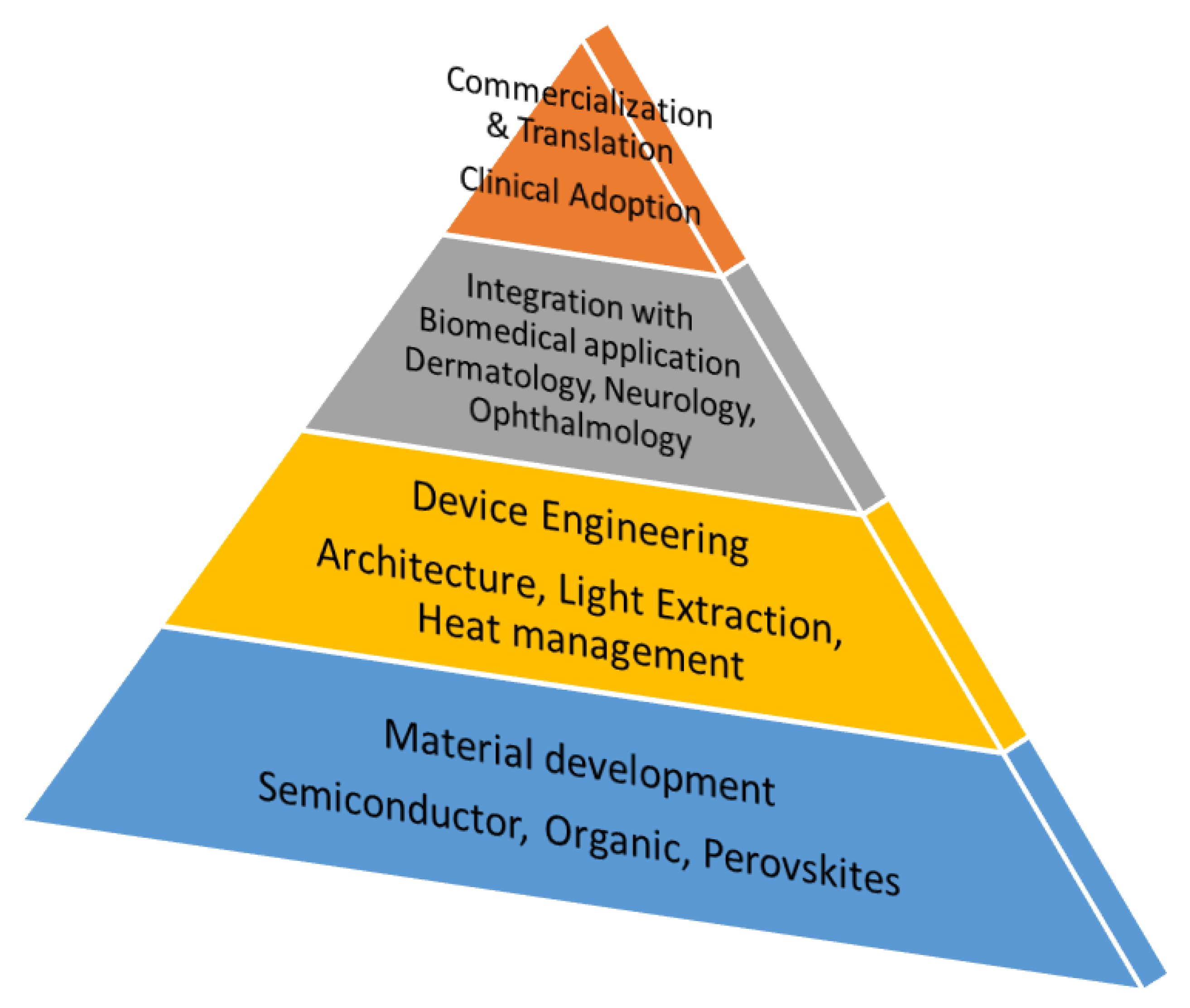

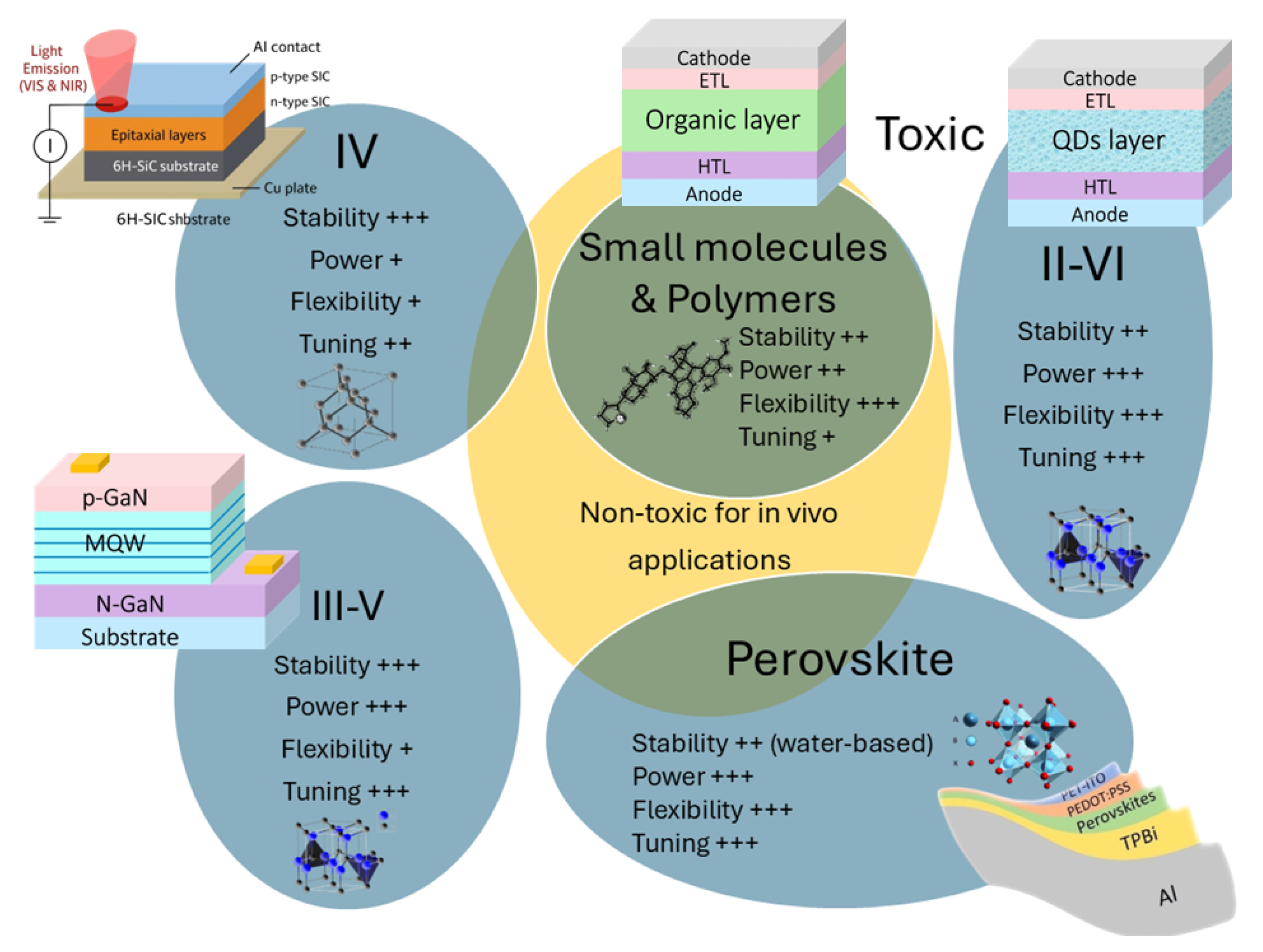
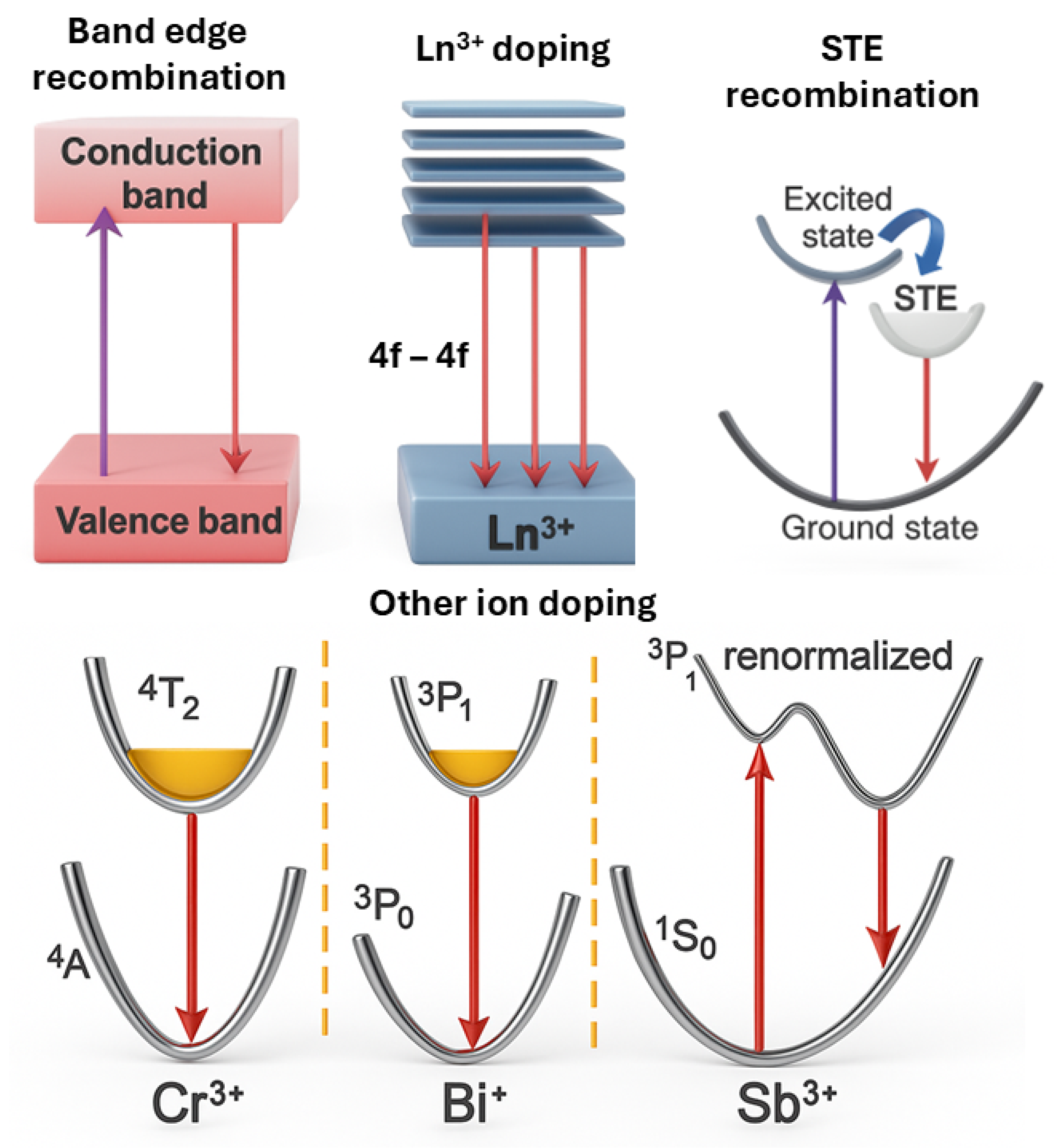
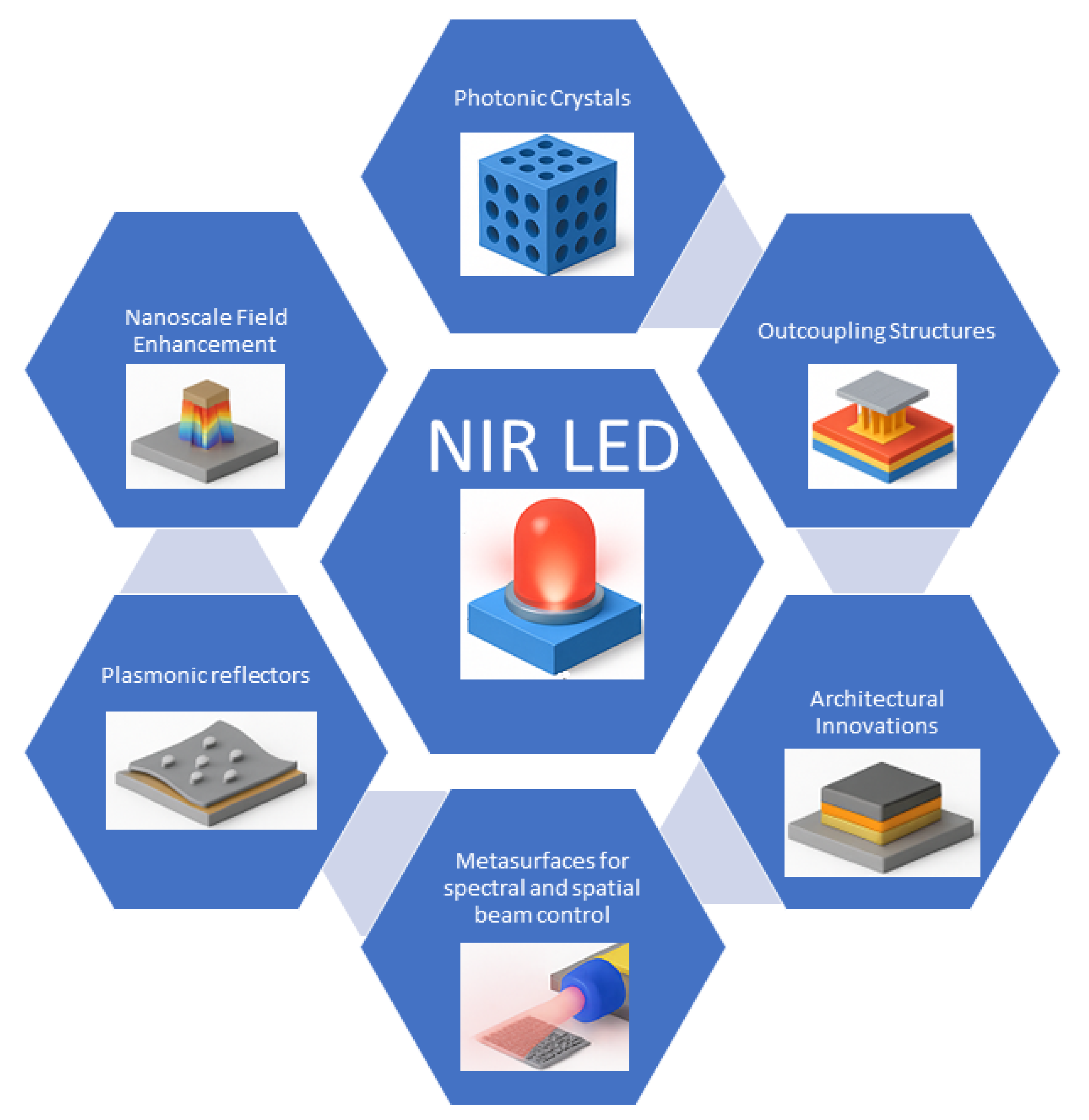
| Subjects | Wavelength (nm) | Fluence (J/cm2) | Irradiance (mW/cm2) | Duty Cycle | Session Time | Ref. |
|---|---|---|---|---|---|---|
| Burn wounds * | 785, 830 | 3 | 8.5 | Not specified | Single exposure | [31] |
| Dermal wounds | 810–830 | 1–6 | 5–50 | CW/ PW | Multiple sessions | [2] |
| Full-burn wounds * | 904 | 0.2 | 0.4 | 100 Hz PW | 7 daily sessions | [32] |
| Diabetic wounds * | 904 | 18.3 | 304.8 | 9500 Hz PW | 5 daily sessions | [5] |
| Acute stroke | 808 | 1.2 | 10 | CW | 2 min each side | [28] |
| Traumatic brain injury | 810, 980 | 14.8–28.3 | 10–15 | 10 Hz PW | Multiple sessions | [29] |
| Depressive disorder | 810 | 60 | 250 | CW | 4 min sessions | [30] |
| Age-related macular degeneration | 780 | 0.3 | 0.3 | 292 Hz pulse | 40 s 2 weeks | [18] |
| Amblyopia | 780 | 0.7 | 0.3 | 292 Hz pulse | 30 s 2 weeks | [22] |
| Retinis pigmentosa | 780 | 0.4 | 0.3 | 292 Hz pulse | 40 s 2 weeks | [23] |
| Device radiance, L | |
| Angular profile | Lambertian, half-angle |
| Spot area | 1 cm2 |
| Calculated irradiance, E | 31 W/cm2 (31,000 mW/cm2) |
| Duty cycle | 50% → |
| Session time | 60 s |
| Delivered radiant exposure | 940 J/cm2 |
| Material Classes | λpeak (nm) | FWHM (nm) | EQE (%) | WPE (%) | Rad. /Ir. † | Jro ‡ | S (nm) | LT50 (h) | ΔT (°C) | Ref. |
|---|---|---|---|---|---|---|---|---|---|---|
| III–V (GaAs) | 700–950 | 20–40 | 30–72 | 25–35 | 50–100 | 1–5 | <2 | >103 | 5–8 | [67] |
| IV (SiC) | 900–1000 | 50–80 | 1–5 | 0.5–2 | 5–20 | 0.1–0.5 | >5 | <100 | 3–5 | [38,71] |
| II–VI (CdSe) | 750–875 | 25–35 | 10–21 | 10–15 | 10–50 | 0.5–1 | 2–4 | ∼500 | 5–7 | [10,41] |
| Small molecule | 700–850 | 40–60 | 5–10 | 3–6 | 5–15 | 0.1–0.3 | 5–10 | 100–300 | 2–4 | [10,43] |
| Polymer | 700–950 | 50–80 | 2–20 | 1–3 | 2–10 | 0.05–0.2 | 5–15 | <100 | 2–4 | [10,49] |
| Perovskite (pure) | 700–986 | 20–30 | 10–31 | 10–12 | 20–50 | 0.2–1 | 1–3 | 200–500 | 3–6 | [11,12] |
Disclaimer/Publisher’s Note: The statements, opinions and data contained in all publications are solely those of the individual author(s) and contributor(s) and not of MDPI and/or the editor(s). MDPI and/or the editor(s) disclaim responsibility for any injury to people or property resulting from any ideas, methods, instructions or products referred to in the content. |
© 2025 by the authors. Licensee MDPI, Basel, Switzerland. This article is an open access article distributed under the terms and conditions of the Creative Commons Attribution (CC BY) license (https://creativecommons.org/licenses/by/4.0/).
Share and Cite
Mahato, S.; Hardhienata, H.; Birowosuto, M.D. Perovskites to Photonics: Engineering NIR LEDs for Photobiomodulation. Micromachines 2025, 16, 1002. https://doi.org/10.3390/mi16091002
Mahato S, Hardhienata H, Birowosuto MD. Perovskites to Photonics: Engineering NIR LEDs for Photobiomodulation. Micromachines. 2025; 16(9):1002. https://doi.org/10.3390/mi16091002
Chicago/Turabian StyleMahato, Somnath, Hendradi Hardhienata, and Muhammad Danang Birowosuto. 2025. "Perovskites to Photonics: Engineering NIR LEDs for Photobiomodulation" Micromachines 16, no. 9: 1002. https://doi.org/10.3390/mi16091002
APA StyleMahato, S., Hardhienata, H., & Birowosuto, M. D. (2025). Perovskites to Photonics: Engineering NIR LEDs for Photobiomodulation. Micromachines, 16(9), 1002. https://doi.org/10.3390/mi16091002







